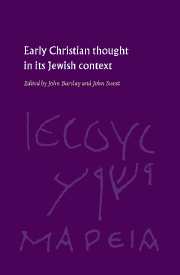Book contents
- Frontmatter
- Contents
- List of contributors
- Preface
- List of works by Morna D. Hooker
- List of abbreviations
- Chapter 1 Introductory Essay
- I THE SOCIAL CONTEXT OF EARLY CHRISTIANITY
- II SOME EARLY CHRISTIAN SOURCES
- Chapter 4 Jesus
- Chapter 5 Matthew
- Chapter 6 Mark
- Chapter 7 Luke–Acts
- Chapter 8 John
- Chapter 9 Paul
- Chapter 10 Deutero-Pauline letters
- Chapter 11 Hebrews
- Chapter 12 Revelation
- Chapter 13 Other early Christian writings: ‘Didache’, Ignatius, ‘Barnabas’, Justin Martyr
- III SOME EARLY CHRISTIAN THEMES
- Index of names
- Index of subjects
- Index of texts
Chapter 12 - Revelation
from II - SOME EARLY CHRISTIAN SOURCES
Published online by Cambridge University Press: 22 September 2009
- Frontmatter
- Contents
- List of contributors
- Preface
- List of works by Morna D. Hooker
- List of abbreviations
- Chapter 1 Introductory Essay
- I THE SOCIAL CONTEXT OF EARLY CHRISTIANITY
- II SOME EARLY CHRISTIAN SOURCES
- Chapter 4 Jesus
- Chapter 5 Matthew
- Chapter 6 Mark
- Chapter 7 Luke–Acts
- Chapter 8 John
- Chapter 9 Paul
- Chapter 10 Deutero-Pauline letters
- Chapter 11 Hebrews
- Chapter 12 Revelation
- Chapter 13 Other early Christian writings: ‘Didache’, Ignatius, ‘Barnabas’, Justin Martyr
- III SOME EARLY CHRISTIAN THEMES
- Index of names
- Index of subjects
- Index of texts
Summary
THE CONTEXT OF REVELATION: APOCALYPTIC AND PROPHECY
In the lecture which provides the theme for this volume Morna Hooker (1984) urges that we read the New Testament writings in their own context, not ours: what then is the context? The question is raised sharply by Revelation, which though addressed to the Hellenistic cities of the Province of Asia is perhaps the most overtly Jewish book in the New Testament, or at least the most scriptural. But what sort of Judaism? Does the scriptural texture spring from living experience, as in the Thanksgiving Hymns of Qumran, or is it literary and antiquarian? The book claims to be apocalypse (I.I) and prophecy (I.3), but these terms have been seen as representing types of literature and religious positions which are poles apart. Apocalyptic is held to be other-worldly, dualistic, pessimistic, esoteric, sectarian – looking to the imminent end of this corrupt world, but centred in the literary past and divorced from the main stream of national life (Vielhauer 1965, pp. 581–600). Prophecy on the other hand works with hope of restoration within this world – a salvation dependent on repentance and obedience to Torah, as interpreted by the down to earth Pharisees and their rabbinic successors
This now looks like a caricature. Koch (1972) gave a devastating analysis of scholarly misunderstanding and neglect of apocalyptic; and Rowland (1982, 1988b) and others have given a different picture of apocalyptic, drawn from the actual texts, as concerned with revelation rather than eschatology.
- Type
- Chapter
- Information
- Early Christian Thought in its Jewish Context , pp. 160 - 173Publisher: Cambridge University PressPrint publication year: 1996



